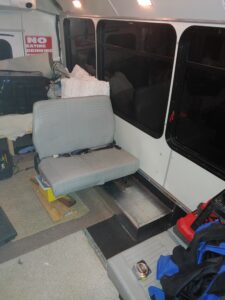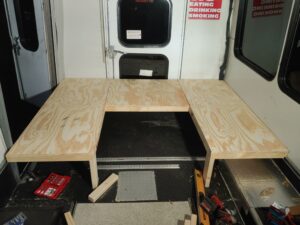Several months into the COVID-19 pandemic, we purchased a retired shuttle bus from a government auction. We wanted a way to travel while still following the CDC guidelines on safe social distancing. Before deciding on the eleven-passenger shuttle bus, we considered a small RV but found them to be too expensive and not fuel-efficient. We also wanted to be able to park in a regular size parking spot without worrying too much about getting stuck. The bus we purchased met all of our criteria, including a dual fuel kit.
A dual fuel kit allows the bus to run on gasoline or propane, and we are planning to utilize the propane system to run the bus on biogas for short trips around town. With a small-scale home digester, we use our food scraps to produce methane through a process called anaerobic digestion. It is most commonly used for cooking fuel, but we hope to run our shuttle bus on it, think of it as a vegetafuel!
Anaerobic digestion (AD) is the process of microorganisms breaking down biodegradable materials in the absence of oxygen. The end result is a clean-burning fuel with numerous uses. If you’ve read our blogs before, you’re probably familiar with AD. I’ve added links to past posts about digesters and the AD process if you’d like to learn more. It is a highly beneficial process that diverts food waste from landfills, reducing greenhouse gas emissions into the atmosphere. It also produces a nutrient-rich fertilizer for gardens in addition to making a usable fuel.
We’ve been working on getting the bus’s interior done before moving on to the fuel conversion. We opted not to totally gut it as it already came with an insulation package, and it seemed wasteful to remove it and redo it. We removed the wheelchair ramp and most of the seats and built a sitting area in the back that can convert into a bed. We turned two double seats for the dining area to face each other and will install a table between them. Our goal is to reuse a lot of the components from the bus to reduce our waste. There are a lot of options when it comes to reusing and repurposing As our kids get older, they can not only eat at the table but use it to draw, do puzzles, etc., on long road trips.
For the kitchen area, we installed kitchen cabinets that we painted blue-grey. We are planning to install a sink and faucet soon but have been using it as is to help us decide where we’d like it to go in the countertop. For now, we are using a discount-damaged Formica top from Lowe’s but will eventually use a piece of live edge black walnut from our old house. Adding two solar panels to the roof is also on our to-do list. These panels will allow us to charge a lithium power station we purchased and a back-up storage system. It can also help us keep the lights on when the bus is off and provide A/C and heat for short periods.
When we first got the bus, we drove it around as-is for several weeks. This helped us see what we really needed to be comfortable and how it would best function. It is easy to get swept away in all of the beautiful conversions on the internet, but some ideas we liked just weren’t functional for our family’s needs.
We knew we would mostly be using it for day trips, so we wanted a lot of storage and comfortable seating. We’ve taken it to Claytor Lake for the day, the Explore Park in Roanoke, Virginia, and Lake Ridge in Hillsville, Virginia. Beyond all-day trips, it also works great as a way to get a change of scenario, even for an hour or two. With all of the ice the New River Valley has seen this winter, we’ve spent so much time stuck inside. It’s been too slippery and dangerous to play outside, and with social distancing, we rarely go inside public areas. But we can pack a lunch, drive someplace new, and find a neat place to park and eat at. The bus has many big windows, and just having an hour or two out of the house to see something different helps everyone’s spirits. We’ve deemed these times as bus parties, and our two children love them! I don’t know what it is about a small space on wheels, but they always manage to have a blast in it.
Over the next few weeks, we will be adding blogs with more in-depth information about the shuttle bus conversion, including the solar hookup, the batteries, the dual-fuel system, and more. If you and your family are interested in learning more about bus conversion, you can contact us through the website. There are many choices, and we can help you figure out your unique needs and the best execution. From choosing a bus, insulation, and lighting to solar systems, power stations, and configurations, EarthMore has you covered.
Below are two blogs about anaerobic digestion, one highlights an install at a farm and the other is a small introduction to research on using solar thermal heating for AD.
https://www.sustainableexperts.com/anaerobic-digestion/anaerobic-digestion.html



